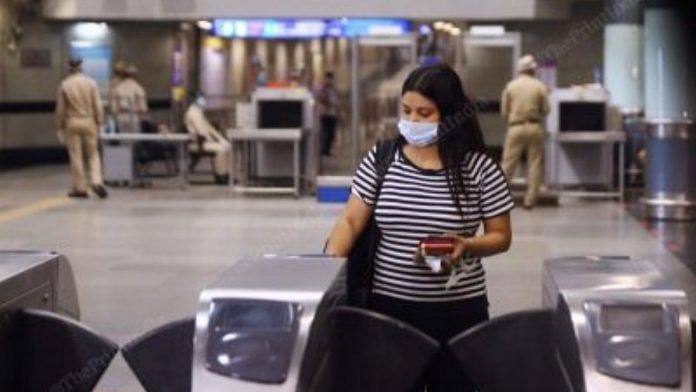New Delhi: The automatic fare collection system in the upcoming Phase-IV lines of the Delhi Metro will be fully compliant with the National Common Mobility Card (NCMC), and commuters will also be able to use a mobile phone to enter or exit a station on its corridors, DMRC chief Mangu Singh has said.
Asserting that Delhi Metro is a “modern metro system” comparable to the best in the world, he also said that these two facilities might be rolled out at the Airport Express Line by the end of this year.
Prime Minister Narendra Modi in March 2019 had launched the indigenously-developed NCMC to enable people to pay multiple kinds of transport charges, including for metro and bus services across the country, through a common card.
Dubbed as ‘One Nation One Card’, the inter-operable transport card would allow the holders to also pay their toll taxes, parking charges, retail shopping and even withdraw money.
Singh said the facility to use mobile phones to enter or exit automatic fare collection (AFC) gates, are available in major modern modern systems in various countries, including in the Seoul Metro.
“We are working to continuously improve our system, with better technological and other interventions, to improve our rolling stocks and energy efficiency. In Ph-IV, our AFC system will fully accept the national common mobility cards, which can be used in any cities,” he told PTI.
“Also, a mobile phone will effectively work as smart card, and riders will be able to use to enter or exit the AFC gates, in Ph-IV lines,” Singh said.
The managing director of the Delhi Metro Rail Corporation, however, underlined that e-payment system and technology are fast-evolving and by the time the Ph-IV work is complete, new technologies may emerge.
Also read: Yellow, Blue, Magenta, Red — Delhi’s metro lines are now running like it’s business as usual
“But, we have been working on it for quite some time, and the facilities of NCMC and entry and exit using mobile phones might be available by the end of this year on the Airport Express Line” he added.
Currently, riders on the Airport Express Line can also enter or exit AFC gates using a QR code on mobile phone that has to be collected from a mertro counter, but the future plan is to have a system whereby commuters can generate their own QR codes on phones and enter through AFC gates using that facility, the top official said.
The DMRC chief said, these two facilities will be first available on the brand new lines to be built under Ph-IV, and hopefully by the time the construction is over, the corridors to be built under this phase as extensions of existing lines, would “also be upgraded” for compliance.
Asked if old smart cards will work in Ph-IV lines, he said, “Yes.”
The Union Cabinet, in a meeting chaired by the Prime Minister, in March last year had approved three out of the six corridors of the Delhi Metro’s proposed phase IV.
Under approved segment of Phase-IV, 61.679-km of new metro lines shall be constructed across three different corridors comprising 45 metro stations. These new sections shall provide interconnectivity among the already operational lines of the Delhi Metro.
According to the government, the Mukundpur-Maujpur, R K Ashram-Janakpuri West and Aerocity-Tughlakabad corridors were approved by the Cabinet.
The other three proposed corridors of Phase-IV which have not yet been approved by the Union Cabinet are Rithala-Bawana-Narela, Inderlok-Indraprastha and Lajpat Nagar-Saket G Block.
After a long wait, work had begun on the construction of Delhi Metro’s Phase-IV project with a groundbreaking ceremony held at Haider Badli Mor here on December 30 last year.
And, with that piling work had begun for construction of 10 stations of 28.92-km Janakpuri West-R K Ashram Marg corridor, which is an extension of the Magenta Line and will have a total of 22 stations.
Asked about the status of construction of stations under Ph-IV, Singh said, tenders have been floated and finalised for all the major elevated sections.
The DMRC chief said Ph-IV work has been affected by the COVID-19 situation but the ongoing project will get delayed only by a couple of months and the therefore “won’t entail much cost escalation”.
“Individual projects have longer timelines, so impact wouldn’t be much. And, construction work has not been affected really as funding for such projects comes from JICA (Japan International Cooperation Agency) loans. Also, 80-90 labourers are back after they had moved back to their native places due to the pandemic,” he said.
“So, work is going on in full swing now,” Singh asserted.
On the status of three remaining corridors of Ph-IV, he said, “currently there is a setback to all new projects, as far as central government is concerned, so we expect some delay in getting the sanctions”.
“If sanction happens in a year’s time say, but we are keeping ourselves ready by then with the design and detailing. Also, from time of approval, work will begin in one-and-a-half year time, and completion time likely to be two-and-a-half years from then,” he said.
The Ph-4 project will see many highs and several firsts for the DMRC, including the first-ever metro bridge over Yamuna to be built using the cantilever construction technique, and the highest point in the DMRC system, at Haiderpur Badli Mor, where the viaduct level is going to be at 28 m. -PTI
Also read: Delhi Metro restart — hopeless autos, 3-step sanitisation & deserted Rajiv Chowk






